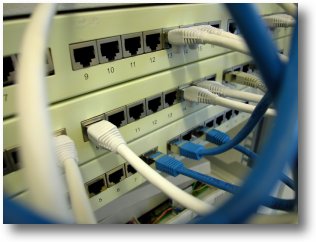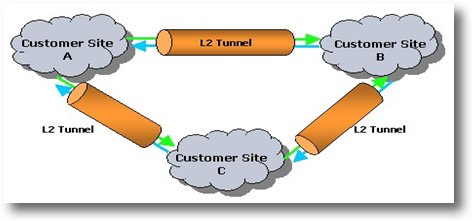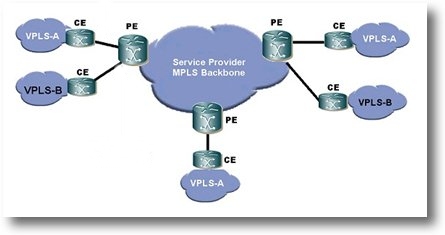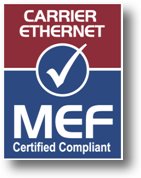Ethernet-over-Everything - what's Everything?
March 2007
 And you thought Ethernet was simple! It
seems I am following a little bit of an Ethernet theme at the moment, so I thought that I would have a go at listing all (many?) of the ways Ethernet packets can be moved from from one location to
another. Personally I've always found this confusing as there seems to be a plethora of acronyms and standards. I will not cover wireless standards in this post.
And you thought Ethernet was simple! It
seems I am following a little bit of an Ethernet theme at the moment, so I thought that I would have a go at listing all (many?) of the ways Ethernet packets can be moved from from one location to
another. Personally I've always found this confusing as there seems to be a plethora of acronyms and standards. I will not cover wireless standards in this post.
Like IP (Internet protocol not Intellectual Property!), the characteristics of an Ethernet connection is only as good as the bearer service, it is being carried over and thus most of the standards are concerned with that aspect. Of course, IP is most often carried over Ethernet so performance characteristics of the Ethernet data path bleed through to IP as well. Aspects such as service resilience and Quality of Service (QoS) are particularly important.
Here are the ways that I have come across to transport Ethernet.
Native Ethernet
Native Ethernet in its original definition runs over twisted-pair, coaxial cables or fibre (Even though Metcalfe called their cables The Ether). A core feature called carrier sense multiple access with collision detection (CSMA/CD) enabled multiple computers to share the same transmission medium. Essentially this works by a node resending a packet when it did not arrive at its destination because it was lost by colliding with a packet sent from another node at the same time. This is one of the principle aspect of native Ethernet that is when used on a wide area basis as it is not needed.
Virtual LANs (VLANs): An additional capability to Ethernet was defined by the IEEE 802.1Q standard to enable multiple Ethernet segments in an enterprise to be bridged or interconnected sharing the same physical coaxial cable or fibre while keeping each bridge private. VLANs are focused on single administrative domain where all equipment configurations are planned and managed by a single entity. What is know as Q-in-Q (VLAN stacking) emerged as the de facto technique for preserving customer VLAN settings and providing transparency across a provider network.
IEEE 802.1ad (Provider Bridges) is an amendment to IEEE 802.1Q-1998 standard that the definition of Ethernet frames with multiple VLAN tags.
Ethernet in the First Mile (EFM): In June, 2004, the IEEE approved a formal specification developed by its IEEE 802.3ah task force. EFM focuses on standardising a number of aspects that will help Ethernet from a network access perspective. In particular it aims to provide a single global standard enabling complete interoperability of services. The standards activity encompasses: EFM over fibre, EFM over copper, EFM over passive optical network and Ethernet First Mile Operation, Administration, and Maintenance. Combined with whatever technology a carrier deploys to carry Ethernet over its core network, EFS enables full end-to-end Ethernet wide area services to be offered.
Over Dense Wave Division Multiplex (DWDM) optical networks
10GbE: The 10Gbit/s Ethernet standard was published in 2006 and offers full duplex capability by dropping CSMA/CD. 10GbE can be delivered over carrier's DWDM optical network.
Over SONET / SDH
Ethernet over Sonet / SDH (EoS): For those carriers that have deployed SONET / SDH networks to support their traditional voice and TDM data services, EoS is a natural service to offer following a keep it simple approach as it does not involve tunnelling as would be needed using IP/MPLS as the transmission medium. Ethernet frames are encapsulated into SDH Virtual Containers. This technology is often preferred by customers as it does not involve the transmission of Ethernet via encapsulation over an IP or MPLS shared network which is often seen as a perceived performance or security risk by enterprises (I always see this as a non-logical concern as ALL public networks use shared networks at all levels).
LAPS: Link Access Procedure - SDH: LAPS is a variant of the original LAP protocol, is an encapsulation scheme for Ethernet over SONET/SDH. LAPS provides a point-to-point connectionless service over SONET/SDH. and enables the encapsulation of IP and Ethernet data.
Over IP and MPLS:
Layer 2 Tunnelling Protocol (L2TP). L2TP was originally standardised in 1999 but an updated version was published in 2005- L2TPv3. L2TP is a Layer 2 data-link protocol that enables data link protocols to be carried on IP networks along side PPP. This includes Ethernet, frame relay and ATM. L2TPv3 is essentially a point-to-point tunnelling protocol that is used to interconnect single- domain enterprise sites.
L2TPv3 is also known as a Virtual Private Wire service (VPWS) and is aimed at native IP networks. As it is a pseudowire technology it is grouped with Any Transport over MPLS (AToM).
Layer 2 MPLS VPN (L2VPN): Customer's networks are separated from each other on a shared MPLS network using MPLS Label Distribution Protocol (LDP) to set up point-to-point Pseudo Wire Ethernet links. The picture below shows individual customer sites that are relatively near to each other connected by L2TPv3 or L2VPN tunnelling technology based on MPLS Label Switched paths.

Virtual Private LAN Service (VPLS): A VPLS is a method of providing a fully meshed multipoint wide area Ethernet service using Pseudo Wire tunnelling technology. VLPS is a Virtual Private Network (VPN) that enables all LANs on a customer's premises connected to it are able to communicate with each other. A new carrier that has invested in an MPLS network rather than an SDH / SONET core network would use VPLS to offer Ethernet VPNs to their customers. The picture below shows a VPLS with LSP link containing multiple MPLS Pseudo-Wires tunnels.

 MEF: The MEF
defines several types of Virtual Private Wire Services (VPWS) services:
MEF: The MEF
defines several types of Virtual Private Wire Services (VPWS) services:
Ethernet Private Line (EPL). An EPL service supports a single Ethernet VC (EVC) between two customer sites.
Ethernet Virtual Private Line (EVPL). An EVPL service supports multiple EVCs between two two customer sites.
Virtual Private Line Service (VPLS) or Ethernet LAN (E-LAN) service supports multiple EVCs between multiple customer sites.
These MEF-created service definitions, which are not standards as such (indeed they are independent of standards), enable equipment vendors and service providers to achieve 3rd certification for their products.
Looking forward:
100GbE: In 2006, the IEEE's Higher Speed Study Group (HSSG), tasked with exploring what Ethernet's next speed might be, voted to pursue 100G Ethernet over other offerings, such as 40Gbit/s Ethernet to be delivered in the 2009 /10 time frame. The IEEE will work to standardize 100G Ethernet over distances as far as 6 miles over single-mode fiber optic cabling and 328 feet over multimode fibre.
PBT or PBB-TE: PBT is a group of enhancements to Ethernet that are defined in the IEEE�s Provider Backbone Bridging Traffic Engineering (PBBTE) group. I've covered this in Ethernet goes carrier grade with PBT / PBB-TE?
T-MPLS: -MPLS is a recent derivative of MPLS - I have covered this in PBB-TE / PBT or will it be T-MPLS?
Well, I hope I've covered most of the Ethernet wide area transmission standards activities here. If I havn't I'll add others as addendums. At least they are all on one page!
